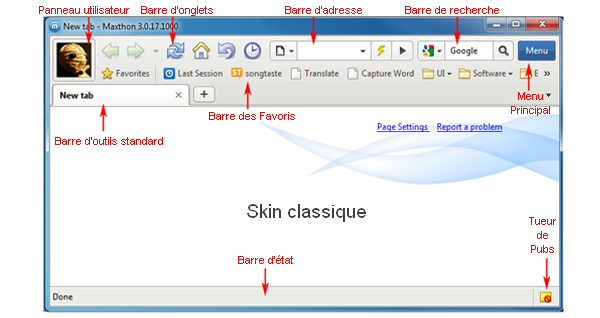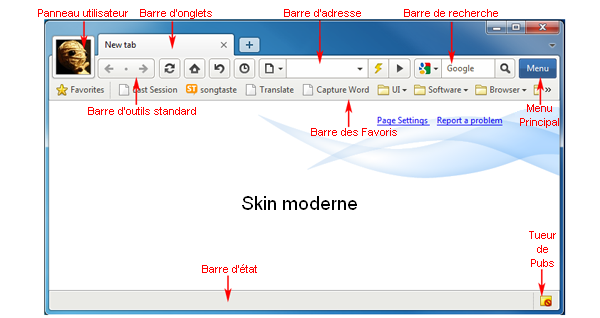« Interface utilisateur » : différence entre les versions
Aucun résumé des modifications |
Aucun résumé des modifications |
||
| Ligne 31 : | Ligne 31 : | ||
'''1.''' | '''1.''' Chaque site ouvert sera présent dans la barre d'onglet en haut de Maxthon 3. Le titre et l'icône des sites seront affichés sur chaque onglet. Cliquez sur un onglet différent pour changer de site. | ||
Version du 30 août 2010 à 09:28
Disposition
Il y a deux Skins officiels pour Maxthon 3 : Moderne et Classique. Le Skin Moderne est celui utilisé par défaut. Vous le verez lorsque vous installerez Maxthon 3 la première fois. Le Skin Classique est, comment dire... classique. Cliquez sur "Changer de Skin" dans le menu pour passer d'un Skin à l'autre.
Panneau utilisateur
Cliquez sur le bouton dans le coin supérieur gauche pour ouvrir votre panneau utilisateur. Avant votre connexion, il affichera un smiley bleu. Après votre connexion il affichera votre avatar si vous avez pris le temps d'en sélectionner un. Si vous n'avez pas d'avatar, choisissez-vous en un !
Avant connexion  Après connexion
Après connexion 
Menu
Cliquez sur le bouton "Menu" pour configurer les réglages de Maxthon 3.
Barre d'onglets
1. Chaque site ouvert sera présent dans la barre d'onglet en haut de Maxthon 3. Le titre et l'icône des sites seront affichés sur chaque onglet. Cliquez sur un onglet différent pour changer de site.
2. To open a brand new, blank page click the "Create New Tab" button ![]() . Right-click the button to open a URL saved in your clipboard.
. Right-click the button to open a URL saved in your clipboard.
3. Click the arrow button ![]() to show the list of opened sites. You can switch between sites and close all tabs using this list.
to show the list of opened sites. You can switch between sites and close all tabs using this list.
1. Click Backward ![]() to return to the last visited page. Click Forward/Backward/History
to return to the last visited page. Click Forward/Backward/History ![]() to view the list of last pages opened in your current tab. Click Forward
to view the list of last pages opened in your current tab. Click Forward ![]() to view the next page open (if there is one) in your current tab.
to view the next page open (if there is one) in your current tab.
2. Click Refresh ![]() to reload the current tab.
to reload the current tab.
3. Click Homepage ![]() to open the site you set as the homepage.
to open the site you set as the homepage.
4. When the Favorites bar is hidden, click Favorites ![]() to restore and display it.
to restore and display it.
5. Click Undo ![]() to open your last closed sites.
to open your last closed sites.
6. Click Undo list ![]() to show all recently-closed sites.
to show all recently-closed sites.
Barre d'adresse
1. Click the Page Menu icon ![]() to show the page menu. It contains options to zoom in or out, print or search for a term in the page. That's not all, too...
to show the page menu. It contains options to zoom in or out, print or search for a term in the page. That's not all, too...
2. Type address in address box and visit the sites. Or type keywords in address box to search the web. For more information please visit the "Smart Address Bar".
3. Use the Dual Display Engines button to switch between Ultra Mode and Retro Mode. The lightning icon ![]() shows when you're in Ultra mode. That means the browser is using the Webkit engine, which makes your surfing much better for the majority of websites you'll visit. The blue icon
shows when you're in Ultra mode. That means the browser is using the Webkit engine, which makes your surfing much better for the majority of websites you'll visit. The blue icon ![]() refers to Retro mode -- which uses the Trident engine, better for older, outdated, Microsoft IE-enhanced websites.
refers to Retro mode -- which uses the Trident engine, better for older, outdated, Microsoft IE-enhanced websites.
4.Click "Go to" ![]() to visit the address typed in the address box or to perform a web search. While your page loads, this button will function as a "Stop" button.
to visit the address typed in the address box or to perform a web search. While your page loads, this button will function as a "Stop" button. ![]() Clicking "Stop" will cancel the page load process for that page.
Clicking "Stop" will cancel the page load process for that page.
Barree de recherche
1. Click the "Select Engine" ![]() icon to set your default search engine. The default is Bing.
icon to set your default search engine. The default is Bing.
2. Type keywords right in the search box, press "Enter" or "Search" button ![]() to start searching the web.
to start searching the web.
Barre des Favoris
Setting Maxthon to show the Favorites bar(Or press Ctrl+B to show it), will cause your favorites to be displayed under the address bar.
Barre d'état
1. The Status Bar shows the information from the page that is loading and other tips about the Maxthon browser.
2. AD Hunter ![]() shows the number of Popup windows blocked by Maxthon. For example
shows the number of Popup windows blocked by Maxthon. For example ![]() means four popup windows have been blocked by Maxthon. Click the icon and open the list of blocked sites. You can access these sites from this list.
means four popup windows have been blocked by Maxthon. Click the icon and open the list of blocked sites. You can access these sites from this list.

